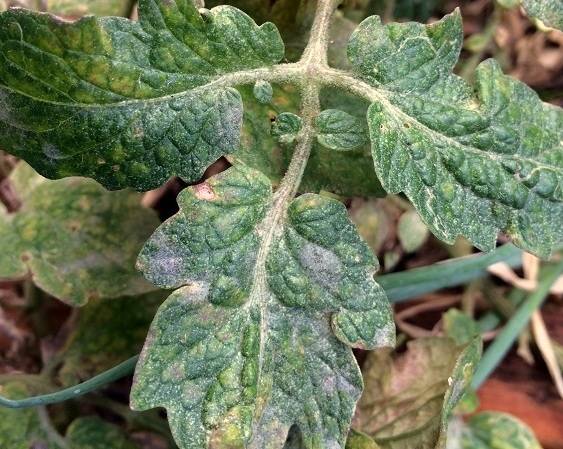Susan asks: The leaves on my squash plant have yellow spots and some grayish dust spots. What is the problem and what can I do about it?
Susan asks: The leaves on my squash plant have yellow spots and some grayish dust spots. What is the problem and what can I do about it?
Tropical Gardener answer: You may have two things going on. The yellow spots may indicate a nutrient deficiency. If you haven’t fertilized lately, do so now. Select a fertilizer with a balanced N-P-K rating and some micronutrients. Apply it to the soil and water it in.
The grayish spots are probably powdery mildew. This is a fungal disease that affects many plants including cucurbits like squash, cucumbers, melons and pumpkins. Once the white or gray powder appears, the leaves may start to turn yellow and become deformed and eventually die. Since plants need their leaves to survive, powdery mildew can be deadly and should be treated immediately.
Since you are seeing symptoms on your leaves now, you may want to treat your plant to slow down or stop the spread of the disease to other leaves or plants.
The UH publication on powdery mildew at https://www.ctahr.hawaii.edu/oc/freepubs/pdf/PD-98.pdf recommends wettable sulfur to control powdery mildew. A homemade product has also proven effective in controlling this disease. This is made with baking soda, oil and soap in the following proportions in a gallon of water.
• 1-2 T baking soda (Sodium bicarbonate. Its alkalinity retards the fungus’ growth)
• 1-2 T cooking oil or light horticultural oil (as a sticker). Neem oil is recommended as it has insecticidal properties and may also ward off insects that can cause other diseases.
• 1 t liquid soap or an insecticidal soap (as a wetting agent that can help combine and spread ingredients. Safer insecticidal soap works well.)
Mix all ingredients thoroughly in 1 gallon of water and apply to infected foliage late in the day so as not to fry the leaves in hot sun. This can be applied weekly until all signs of the disease are gone. It can also be used regularly as a prophylactic treatment. Spray every other week to keep fungal diseases at bay.
As with many plant problems, preventing the conditions that cause them is the best remedy. For future plantings look for seeds that are for varieties resistant to powdery mildew.
Avoiding environmental conditions that encourage this disease can also help. This fungus thrives in hot, dry weather especially in dense plantings and in shaded or low light areas or those with high relative humidity. Powdery mildew can spread quickly in warm, dry weather with occasional periods of coolness or high humidity. Reducing the humidity in the area by removing weeds that hold moisture at night can help. Watering early in the day and only on the soil around your plants avoiding getting water on the plant’s leaves can also aid in prevention.
Since spores of fungal diseases can remain dormant in the soil awaiting ideal conditions, you might want to plant your cucurbits elsewhere next season and replace them with plants that do host this particular fungus.
Email plant questions to konamg@ctahr.hawaii.edu for answers by Certified Master Gardeners. Some questions will be chosen for inclusion in this column.
Diana Duff is a plant adviser, educator and consultant living in a dryland forest north of Kailua-Kona.
Gardening Events
Wednesday: “Biodigester Workshop” from 9 a.m. to noon at Doug Pittman’s farm in South Kona. Doug will demonstrate ways to construct a biodigester that creates fuel and fertilizer from green waste. $20 to members of Hawaii Organic Farmer’s Association/ $25 to non-members. Attendees meet at 8 a.m. in the lower South end of Kealakekua Ranch Center parking lot to carpool. For more information or to register, call HOFA president, Una Greenway at 328-8888 or go to www.hawaiiorganic.org.
Thursday: “GoFarm Hawaii – AgCurious Seminar” from 5:30 to 8:30 p.m. at North Hawaii Education &Research Center in Honokaa. For those interested in becoming a production farmer in Hawaii. Applications for the GoFarm Hawaii program will only be available to those in attendance. Register through derrick@gofarmhawaii.org or (808) 220-2312. Program Information: www.gofarmhawaii.org.
Saturday: “Work Day at Amy Greenwell Garden” from 9 a.m. to 12:30 p.m. Meet at the Garden Visitor Center across from the Manago Hotel in Captain Cook. Volunteers will be able to help with garden maintenance and are invited to bring a brown bag lunch. Water and snacks provided. Call Peter at 323-3318 for more information.
Farmer Direct Markets
Wednesday: “Sunset Farmers Market” 2 to 6 p.m. in the HPM parking lot at 74-5511 Luhia Street in Kailua-Kona (across from Target)
Wednesday &Friday: “Hooulu Farmers Market” 9 a.m. to 2 p.m. at Sheraton Kona Resort &Spa at Keauhou Bay
Friday: “Pure Kona Market” 9 a.m. to 5 p.m. at Amy Greenwell Garden in Captain Cook
Saturday: “Keauhou Farmers Market” 8 a.m. to noon at Keauhou Shopping Center
“Kamuela Farmer’s Market” from 7 a.m. to noon at Pukalani Stables
Sunday: “Pure Kona Green Market” 9 a.m. – 2 p.m. at Amy Greenwell Garden in Captain Cook
Tuesday – Saturday: “U-Pick greens and produce” 10 a.m. to 4 p.m. Tropical Edibles Nursery, Captain Cook.
Plant Advice Lines
Anytime: konamg@ctahr.hawaii.edu Tuesdays &Thursdays: 9 a.m. to noon at UH-CES in Kainaliu – 322-4892
Mon., Tues. &Fri: 9 a.m. to noon at UH CES at Komohana in Hilo 981-5199 or himga@hawaii.edu

